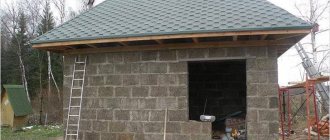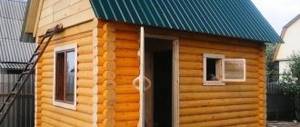The idea of building a bathhouse from a container looks quite unusual. It would seem, why equip a bathhouse in a metal box if you can build a light frame building and arrange the bathhouse according to all the rules. Perhaps the idea is worth trying to put it into practice. Well-appointed houses and cottages are built from container structures, why not at least try to plan how to make a bathhouse from a container.
What is the value of a container bath
Making a bathhouse from a container box is relatively easy. All you need to do is develop and plan:
- A system of powerful insulation of metal walls, otherwise in winter the sauna from a container will turn into a glacier covered with condensation, and in summer in the sun the temperature will easily reach 70 ° C;
- Ventilation diagram of the internal space and auxiliary insulation cavities;
- Water supply for shower and steam room;
- Installation of a stove or electrical heating connection for lamps and fan drives.
All this is not difficult to do, if not for one “but”. On the one hand, it is possible to sheathe or cover a metal box with bricks, SIP panels, aerated concrete slabs, and problems with room insulation and corrosion protection would be solved. But why then fence a garden with a heavy metal body? Offhand it turns out that it is cheaper to build a bathhouse without a container insert.
Most owners choose to build a bathhouse from a container, photo, if they require:
- Build a bathhouse with a strong frame for installation on heaving loams or sandy quicksand. Buying and building a full-fledged bathhouse from a 20 English foot container will cost less than the hassle of rearranging timber or log crowns;
- Make a small-sized steam room on wheels, which can be taken for a season to a vacation spot, to a country house, or to a full-scale construction site. A bathhouse made from a 5-ton container can easily fit in the back of a Bull or a Ford truck.
Important!
A container bathhouse does not require a full foundation, regardless of whether it is a bathhouse made from a 20-foot container, or whether it is planned to use several 5-ton boxes. A flat area filled with sand and gravel is sufficient. Several container boxes, one of which is allocated for a dacha, after finishing and connecting communications, can easily serve as a full-fledged country house.
If the five-ton truck is used as an extension to an ordinary country house, the task can be simplified. For example, make only a steam room out of a container, and use the premises of a country house for relaxation and washing.
After trimming the side walls, the container body can become a frame for arranging an ordinary stationary bathhouse, built in accordance with all the rules and laws of heating engineering.
To do this, you don’t need to purchase a new or a whole container; you can buy a box with holes in the walls literally for the price of scrap metal, and it will be cheaper than:
- Pour the foundation;
- Spend half a cube of high-quality timber on the arrangement of racks and the upper and lower frame of the frame of the future bathhouse.
It will only be necessary to insulate the bathhouse on a container frame and veneer it both on the inside and on the outside of the building.
Advantages of using a container as a basis for building a bathhouse
The bathhouse container has a number of advantages and attractive nuances that distinguish it from its direct competitors:
- Using a container as a basis for building a bathhouse guarantees a low budget for the event. Very often, a container can be purchased inexpensively, and modern handling machines can easily load, deliver and unload the container at a construction site. Problems may arise with 40-foot products and to transport them you will need a semi-trailer and a crane with the appropriate characteristics;
- The container is endowed with an excessive margin of safety and has consistent and strict geometric planes, which allows even an amateur who is inexperienced in construction subtleties to build a bathhouse;
- The container design provides for the possibility of a block or modular arrangement of several units, both in the horizontal and vertical planes;
- The fitting-lock fastening system allows you to quickly and reliably fasten the structure on column-type foundations, which are more technologically advanced and easier to lay than strip foundations. The rigid design of the container block makes it possible to do without additional bracing of the lower perimeter of the container;
- If necessary, the container can be easily dismantled and transported to a new location.
Container bath problems
Most developers planning to build their own bathhouse on a suburban site pay increased attention to container-based steam rooms and sauna projects. Often, three factors, which many private owners are familiar with only through rumors, keep them from building a bathhouse from a container with their own hands:
- Significant cost of implementing a bathhouse project from a container;
- The metal of the case is subject to severe corrosion;
- In the summer, the interior of the steel container turns into a stove.
The main argument of opponents of the idea of building a steam room from a container is the rather small number of offers of a ready-made bathhouse from a 20-foot container on the real estate market. This is not entirely true. Firstly, most specialized construction companies offer custom-made bathhouses from a container according to a standard design. One of the options, costing about 500 thousand rubles, is given below.
Such a bathhouse made from a 20-foot container photo is divided into three rooms with an area of 10-12 m2:
- Steam room with electric stove;
- The second box is a dressing room and a washroom with a shower;
- The third room is reserved for a locker room and a rest room.
The internal space, 6 m long and 2.2 m wide, is lined with clapboard, the external walls can be finished with siding or block house. The price for a finished bathhouse from a 20-foot container is clearly too high, which limits the mass demand for the product.
Secondly, there is a certain shortage of sea containers on the market. Companies involved in the production of premises from sea containers buy them in small quantities from carriers. A new or three-year-old box in good condition will cost at least 40-50 thousand rubles. If you set a goal and build a bathhouse from a 20-foot container for yourself, then with some patience you can find a single box in good condition for 25-30 thousand rubles.
What basics are used to build a bathhouse?
A container is a metal frame made of a channel or corners. When choosing the basis for your future structure, it is better to buy a so-called “sea” container. It is characterized by its large size and high strength.
It is better to give preference to the following sizes
| Options | Dimensions |
| 20ft standard (Dry Cube). | The height is 2591 mm, width is 2438 mm. |
| 20ft high container (High Cube) | Height – 2896, width – 6058 mm. |
| It's even better if you use a 40-foot standard (Dry Van). | Its height is 2591 and its width is 12,192 mm. |
| 40ft high container (High Cube). | It has a height of 2896 and a width of 12,192 mm. |
After selecting a suitable frame and delivering it to the site, you can proceed to the next stage.
How to prevent corrosion
The metal of most container models has practically no special properties. To protect steel walls from moisture and salts, the surface is phosphated and treated with special primers. If you already have plans to build a bath complex, then it is best to equip the bathhouse with your own hands from a sea container.
Such a building will easily last a couple of decades, while ordinary container boxes can be subject to corrosion due to improper ventilation of the steam room and insulation.
Advice! The simplest way to protect a steel body from corrosion is to use zinc or magnesium anodes. The rods are buried in the ground to a depth of 50-70 cm, and the leads are soldered to the metal walls of the room.
Advantages and disadvantages of the design
Before you take on the task of remaking an existing frame yourself, calculate the risks and expected costs. Don't overestimate your skills. It may be better to get an assistant to do the work. In addition, you need to clearly understand what you will get in the end and what advantages this technology has.
Advantages of the structure:
- a container bath will cost the owner less than its analogues;
- this design is mobile: it can easily be transported to any other place;
- hygroscopic: does not get wet or damp;
- not susceptible to damage by insects and fungi.
Cons of the building:
- does not have a very aesthetic appearance;
- requires additional finishing;
- the container may be subject to corrosive processes.
The disadvantages are insignificant, considering that such a bath can be made with your own hands in a short time and not too expensive.
Decoration of the facade of a container bath
The rectangular shape of the steel box simplifies the task somewhat. In the most budget-friendly option, the bathhouse body can simply be painted in a pleasant color, white or red. Light colors are very popular among developers in the southern regions, where it is important to combat the heat of the sun, which heats any metal in the summer. White paint reduces heat by 30-35%. If we add foil thermal insulation to this, then the problem of overheating can be considered solved.
The second most popular finishing method is wall cladding with a block house, wall paneling or regular siding.
If you add a roof and a wooden porch to the wooden cladding, you can successfully hide the very fact of using a container in the construction of a bathhouse under the outer cladding.
If the bathhouse is attached to the house, then it would be quite logical to line it with the same material as the main building. For country and mobile bathhouse options, it is best to limit yourself to painting the external walls. If the container is new, with factory paint, then such a three-layer coating will last much longer than a semi-handicraft repainting with automotive enamel.
Heating device
At the bathhouse design stage, it is worth considering what energy source we will use. This is an important point, because you will need to think about how energy will be supplied and by what methods. Bath boilers are of the following types, namely:
- Electrical.
- Woody.
Depending on the size of the container, 5-20 or 40 pounds, the actual heat source is selected. I would recommend a wood-burning stove, it warms up faster and is more efficient. Well, you should choose the size based on the size of the steel container that will be used as the frame of the building.
In order to provide the bathroom with hot water, it is worth considering in advance the plumbing methods for wiring from the boiler.
How to properly build a sauna from a sea container
Immediately after purchasing a 20-foot container, the first thing you need to do is check for damage to the walls and places with painted over, putty, rusty holes. A rusty hull costs half the price of a container in good condition, so owners widely use automotive putty and marine paints to mask problem areas. You can identify a hole in the wall with a magnet or a special device.
Which foundation to choose for a bathhouse - container
Despite the fact that a bathhouse can stand for many years even on a simple platform with crushed stone, most owners prefer to install it on a foundation.
A lightweight five-ton container for a steam room is usually installed on columnar supports cast in concrete formwork or built of brick. If the place for the bathhouse is chosen in the forest, or on the shore of a reservoir, then it is recommended to make a crushed stone cushion under the supports. To do this, dig mini-pits according to the number of pillars to a depth of 60-70 cm, fill them with a mixture of fine sand and gravel screenings. Such a foundation will support even a forty-foot container.
Often, the owners of a future bathhouse pour a slab foundation under the container block, motivating their decision with insurance against sagging of the building and the desire to install a second floor in the future. This is not the best option for a bathhouse. The container body is so strong that it will withstand even the collapse of 40% of the supports, and the concrete under the floor will require serious insulation of the bathhouse subfloor.
Insulation of container walls and ceilings
The main issue in building a bathhouse is always the choice of insulation method. At the first stage, the walls and ceiling are sheathed with wooden slats, providing a ventilation gap. Next, the material is selected.
Metal walls can be insulated in three ways:
- A multi-layer sandwich made of foamed foil polyethylene with an additional layer of aluminum foil laid on the crate;
- Stone fiber mats with a glued layer of foil film. This type of insulation is used exclusively in saunas;
- A “pie” of polyurethane foam from the inside of the container and polystyrene foam on the outer surface.
Thermal insulation based on polyethylene foam and stone fiber must be sheathed with a vapor barrier. A 20-foot container will require at least one and a half rolls of film.
The insulation layer is sewn up with a wooden lath; for a three-room bathhouse you will need at least 80 m2 of linden or ash finishing. The gap between the container wall and the fiber must be ventilated after each visit to the bathhouse.
You can insulate the container space by spraying polyurethane foam directly onto the metal and sheathing slats. Next, a layer of vapor barrier, film and decorative finishing are laid. In this case, the dew point moves to the metal surface of the container.
The most optimal insulation option is considered to be the internal lining of the steam room compartment of the container with stone fiber with an aluminum screen. Layer thickness is at least 50 mm. Next, the outer walls of the bathhouse are covered with penoplex, at least 50 mm thick. The facade of the container is plastered or covered with clapboard.
Arrangement of the bathhouse floor in a container version
Expanded polystyrene insulation is laid on the floor of the bathhouse, over which a screed with a thickness of at least 100 mm is poured. In shipping containers, the floor is almost always made of thick, moisture-resistant plywood; polystyrene foam and concrete screed can be laid directly on the plywood base.
The next step is to lay a layer of mastic waterproofing over the concrete, install larch logs and install a ventilation system for the underground space. A wooden floor is laid on the joists. Most of the water and condensation that gets on the floorboards will be removed from the subfloor by the ventilation system.
The floor in the dressing room is arranged in a similar way; in the locker room or rest room, you can lay tiles directly on the concrete screed, and a lower level of flooring will make cleaning the premises easier.
How to deal with condensation inside a bathhouse
The steel walls of a container can become a source of serious problems, primarily due to the metal’s impermeability to water vapor. Even with special treatment of metal parts under conditions of warm condensation and detergent vapors, pitting corrosion can form on the walls of the container. Especially if window openings were cut out, holes were drilled for screwing in self-tapping screws, and laying communications.
Wherever the protective coating has been damaged, the metal will rust. In addition, the wooden sheathing on which the entire internal lining is supported easily absorbs moisture even under a layer of varnish or oil impregnation.
There is only one way to prevent container corrosion - by providing effective ventilation. In fact, each room of the container is equipped with its own supply and exhaust ventilation, plus one system for ventilating the subfloor and places where condensation accumulates. Ventilation should be turned on every time lovers of light steam leave the bathhouse and the stove is extinguished. Due to the accumulated heat, the air accelerated by the fans effectively expels condensation at any air temperature outside the container.
Finishing the interior of the bathhouse
According to the standards, the requirements for cladding with wooden slats apply only to the steam room or sauna. In the Turkish bath, the walls of the hot compartment can be finished with ceramic tiles.
The dressing room with shower compartment is lined with wooden panels, clapboard or board. The space for the shower can be separated by a wall and tiled with ceramic tiles. The shower floor is equipped with a drain without a tray, or a plastic shower cabin is simply installed. All parts of the wooden finishing of the bathhouse must be treated with impregnation with fire-retardant additives.
How to properly install a stove in a steam room
Regardless of what type of heater, wood-burning or electric, will be used to heat the container sauna, it is necessary to measure or calculate the volume of the steam room. Based on the resulting cubic capacity, the thermal power of the heater required for the bath and its location are determined.
For a sauna built in a container, the most preferable option would be a wood-burning steel or cast iron heater. It will be difficult to heat the huge steel body of the bathhouse using electricity.
The location for installing the stove is selected next to the partition separating the rooms of the dressing room and the steam room of the bath. The housing is mounted closer to the wall of the container so as not to block the passage and simplify the removal of the pipe. In this case, part of the wooden cladding of the wall behind the stove is removed and replaced with heat-resistant tiles, and the base is laid out of it. A ventilation window is cut out in the wall next to the stove. The second window is cut into the opposite side of the bathhouse wall.
Quality finish
The assembled iron container requires very serious work and finishing. You must carefully check every inch of the iron and remove the old coating. If you see that there are places with some metal corrosion, it should be removed immediately. All corners and crevices must be eliminated and insulated. You also need to insulate the room from the inside. If this work is not done, the bath will heat up poorly and cool down quickly.
The stages of conversion must be carried out very carefully, because the reliability and durability of the structure depends on this.
Of course, it is advisable to insulate an additional metal frame for the structure and provide hydroprotection to the elements. The base of the frame should be protected from atmospheric influences. It is better to use sheathing and mineral wool.
If you want to improve the appearance of a mobile bathhouse made from an iron container, you can sheathe it with timber. Fortunately, our country has enough timber and its cost is very low. This is quite simple to do. On the Internet and in our article you will see most of the answers to your questions. For safety, it is better to treat the wood with an antiseptic with fire protection before installation, because we are building a bathhouse, and this means an increased temperature and a risk of fire.
We also protect it from moisture from the inside, because there is always high humidity in the steam room. The floor in the locker room should be insulated so that it does not draw cold from the ground. This is done by paving several layers of boards with mineral wool. Think in advance about the shower drain, if you have one, and about electricity.
Preparatory work
To build a bathhouse, standard 20-foot glazed containers are used. Less common are 40-foot configurations: a large area is not needed to build a bathhouse from containers. You need to buy new containers, always galvanized. Special requirements apply to the type of foundation: a container bath cannot be placed on a simple slab, as the drainage of water will be blocked.
The land plot is marked taking into account the expected location of the sections of the future building. The most important thing is to determine the places where the largest amount of water will drain. Next, the foundation is prepared. Very rarely the container is placed on piles. Most often, foam blocks, bricks, and wood concrete are laid around the perimeter. A wooden frame is placed on them, on which the marine packaging is subsequently installed. Take into account the following point: regardless of the type of foundation, the building should not be close to the ground; otherwise, water will not be absorbed, resulting in damage to the structure.
In order for the water to go into the ground, you need to remove the top turf and pour waterproofing impregnation in its place. After this, you can begin building the foundation. The bathhouse should be 10-15 away from the main residential building and the same distance from the nearest wells and reservoirs.
Installation of partitions
How to equip the interior space of the room? It is most logical to divide the trailer into three parts:
- Restroom.
- Wash compartments.
- Steam room.
Scheme of a wooden partition for a bath.
This layout will be the most convenient. Partitions are installed between rooms. They need to be made from wood. Usually this is a frame made of beams covered with boards. The boards are covered with clapboard on top.
Having finished equipping the bathhouse, you need to think about treating the walls, ceiling, floor and shelves in the steam room. It should be noted that the recreation area and shower definitely require the application of special compounds. There is high humidity and temperatures are not so high. Such an environment is very favorable for the appearance and spread of rot, mold, fungi, and wood parasites.
For treating surfaces in a bath, there are universal impregnations based on natural oils or wax. These products are presented on the market by Russian and foreign manufacturers, in different price categories. Their actions are approximately the same: they penetrate the pores of wood and form a protective film on the surface. These compounds should not be applied to the shelves in the steam room because they can cause burns.
There are two opinions regarding the need to impregnate wood in a steam room. Some people initially reject the possibility of any additional impact on the materials in the steam room. They claim that any, even natural, compositions will give an undesirable effect when evaporated.
But if left untreated, the wood gradually loses color and may darken after 3 to 5 years. This will worsen the aesthetic properties of the steam room. The finish will have to be changed. The use of impregnations allows you to extend the life of wood for many years. To treat benches and other seating areas, you need to use special natural-based products that do not form films.
THERMAL INSULATION AND FINISHING MEASURES
The surfaces of the bathhouse are thermally insulated with insulation with a foil outer layer sealed with foil tape. For interior decoration, materials are used that do not release toxic substances at high temperatures - wooden lining or ceramic tiles. The wood is treated with compounds approved for use in rooms with high temperatures and humid microclimates.
The floor is covered with a lathing made of wooden beams, on which a removable floorboard is mounted. If necessary, it can be easily dismantled and dried.
After installing the chimney and drainage pipe, the outer surfaces of the container are sheathed with clapboard or other facing material.
Container installation
The module, prepared for installation, is installed on the foundation using a truck crane or raised to the required height using jacks. The position of the metal structure is checked using a building level and fixed to the piles using metal corners.
All metal surfaces are treated with anti-corrosion compounds, and door and window blocks are installed. The module has openings for ventilation, for the chimney and for the drain pipe. The space is zoned with partitions. The frame for them is made of timber, the cladding is made of boards. Doors are installed in partitions.
Preparation for construction
Before building a bathhouse from a sea container, it is necessary to correctly determine its location, taking into account fire safety rules that are relevant for the construction of bathhouses and saunas from any materials:
- the building must be at least 4 m away from the residential building;
- the distance between the bathhouse and the border with the neighboring plot is 5 m or more;
- distance to highways and reservoirs – no less than 20 m.
The following types of sea dry cargo containers are suitable for construction:
- 20´DC is a 20-foot standard container with dimensions 6.1x2.59x2.43 m.
- 20´HC - such modules have the same length and width as a standard 20-foot container, and an increased height of 2.9 m.
- 40´DC. Such modules, having a length of 12.2 m, allow you to build a spacious steam room.
- 40´HC blocks have an increased height of 2.9 m.
When planning the location of a bathhouse on the ground, the convenience of connecting utilities - water supply and drainage - is taken into account. The room itself is zoned as follows: a locker room is located near the entrance, followed by a washing room and a steam room. The stove (wood-burning or electric) is installed in such a way that it simultaneously heats the steam room and the washing room. In accordance with the intended layout, window and door openings are cut out in the metal block.
The selected area is cleared of debris, the soil is leveled and compacted. A pile foundation is usually used as a base for a bathhouse, which provides floor ventilation. The height of the piles above the ground surface is 200-300 mm, the distance between them is 0.5-1.0 m. The supports are connected to each other with a wooden or metal grillage. The wood is treated with bio- and fire retardant compounds. If a steel profile is used to construct a grillage, it must be treated with anti-corrosion compounds. When installing piles, take into account that the structure should be tilted towards the drain.
Features of choosing and installing a stove
Unlike traditional baths, where dozens of types of devices can be used, a compact steam room based on a metal frame can only function with a wood-burning or electric stove. In conditions of cramped free space, many install a compact metal tank. The easiest way is to buy a factory boiler: on the specialized market you can find small, convenient domestic and foreign models.
When choosing a place to install heating equipment, you need to take into account an important condition: heat under the influence of natural air movement must first be directed to the steam room. Therefore, it is recommended to install the stove in the area of the partition separating the washing room from the steam room. A gap of 20 cm must be left between the heating apparatus and the wall in order to comply with fire safety standards.
- Author: Maria Sukhorukikh
Rate this article:
- 5
- 4
- 3
- 2
- 1
(0 votes, average: 0 out of 5)
Share with your friends!










